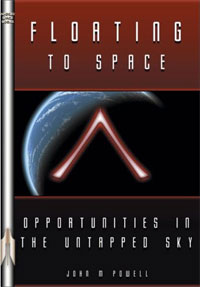
Capsule reviewsby Jeff Foust
|
| The US publishers of Bang!, The Johns Hopkins University Press, go to great lengths to play up May’s authorship, concluding a press release about the book with the line “Bang! It will, it will rock you.” |
As the name suggests, Bang! provides a complete, if rather high-level, history of the universe, moving chronologically from its origins in the Big Bang to its eventual demise in one of a number of ways. (This is the second edition of a book first published in 2006 in the UK; this edition is the first published in the US.) The large-format book is heavily illustrated, and rare is the page without a photo or illustration. Sometimes the connection between the photos and text can seem a little tenuous: why is there a photo of Apollo lunar lander rising from the surface during a discussion about black holes? To illustrate the concept of escape velocity, and how a little spacecraft like the Lunar Module could escape the Moon while a giant Saturn5 was needed to escape the Earth (although, of course, the lunar module didn’t achieve escape velocity, only orbital velocity.) There are also a couple of appendices that provide a discussion of “practical” astronomy (observing the night sky) and some brief bios of key 20th century astronomers.
The US publishers of Bang!, The Johns Hopkins University Press, go to great lengths to play up May’s authorship, concluding a press release about the book with the line “Bang! It will, it will rock you.” (Yes, really.) Will Bang! rock you? The book is a good enough introduction to astronomical concepts like the Big Bang, the formation of stars and galaxies, and what fate the universe might eventually face. If you’re already familiar with those topics, though, you won’t learn much new from this book, other than that there’s at least one rock star who knows a thing or two about real stars.
 |
Floating to Space: The Airship to Orbit Program
By John M. Powell
Apogee Books, 2008
Softcover, 204 pp., illus.
ISBN 978-1-894959-73-5
US$27.95
At the Space Access conference in Phoenix in April 2004, John Powell, president of JP Aerospace, unveiled his group’s highly unconventional plans to transform space transportation. Dubbed “Airship to Orbit” (ATO), the architecture Powell revealed at the conference featured two extremely large airships and the “Dark Sky Station”, a waystation floating over 40 kilometers above the surface in the upper atmosphere, where passengers and cargo would change from one airship to another (see “Floating to Space”, The Space Review, June 1, 2004).
| If you are curious about why JP Aerospace is pursing this concept, and how it might work, Floating to Space allows you to learn about it directly from the source. |
That announcement was met with a mix of befuddlement and skepticism, but Powell and JP Aerospace have pressed on, albeit not at the speed they one envisioned: at the conference they claimed that the first manned flights of a Dark Sky Station prototype would take place in 18 months, a milestone yet to be achieved. While JP Aerospace continues with high-altitude balloon flights, Powell has written Floating to Space, a book that provides an overview of the concept. He interleaves a fictional account of one person’s journey to space via the ATO system with a technical discussion of the concept and the progress JP Aerospace has made on it to date (although the discussion of that progress ends in late 2006, odd for a book published in mid-2008.)
The book could have benefited from another round of copyediting: there are many cases of miscapitalization of words, for example, and places where the text could have been tightened up. The book does include a DVD with videos of some of JP Aerospace’s balloon and rocket tests, but without narration or other explanation, it’s sometimes difficult to appreciate their significance. However, if you are curious about why JP Aerospace is pursing this concept, and how it might work, Floating to Space allows you to learn about it directly from the source.